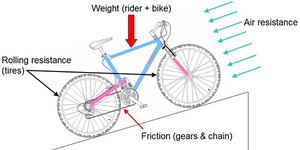Fifth Grade, Sports Science Science Projects (29 results)
Top athletes and coaches use a whole lot of science and engineering to improve performance and increase the chances of winning. Technologies like better tennis rackets, sleeker running and swimming outfits, and aerodynamic soccer balls, mean that current athletes are breaking world records left and right. Add to that better nutrition and science-based training regimes and you have an era of amazing athletes! Explore how science and engineering impact your favorite sport.
|
Select a resource
Coding Projects
Sort by
|
Many sports use a ball in some way or another. We throw them, dribble them, hit them, kick them, and they always bounce back! What makes a ball so bouncy? In this experiment you can investigate the effect of air pressure on ball bouncing.
Read more
Have you ever noticed that when you drop a basketball, its bounce does not reach the height you dropped it from? Why is that? When a basketball bounces, such as on a basketball court, its bounce actually loses momentum by transferring energy elsewhere. This means that to dribble the basketball, players must continually replace the transferred energy by pushing down on the ball. But what happens to the "lost" energy? As we know from physics, energy is not really lost, it just changes form. One…
Read more
New
How do you feel right now? Do you remember how you felt a few hours ago? How about yesterday or last Wednesday? What if you could track your emotions throughout the day and use this information to help improve your mood and well-being? In this science project, you will program a simple, pocket-sized device that you can carry around with you to log your feelings whenever you want or on a specific schedule.
Read more
Playing basketball can be hard work. Players not only constantly run around the court, but just dribbling the basketball takes a lot of effort, too. Why is that? It has to do with how the basketball bounces. When the ball hits the court, its bounce actually loses momentum by transferring some of its energy into a different form. This means that to keep the ball bouncing, players must continually put more energy into the ball. In this sports science project, you will determine how high a…
Read more
Your heart starts beating before you are born and keeps right on going through your whole life. Over an average lifetime, the human heart beats more than 2.5 billion times. Keeping your heart healthy means eating right, not smoking, and getting regular exercise. Which of your favorite physical activities give your heart the best workout and help keep it fit? In this science project, you will use a smartphone equipped with a sensor app to visualize your heart rate and find out which…
Read more
Have you ever seen a "Hail Mary" football pass, where the quarterback tries to throw the ball as far as possible to reach the end zone and score a touchdown? Or a last second game tying soccer goal from midfield? How far the ball will go does not just depend on how hard a player throws or kicks it; it also depends on the angle at which the player launches the ball. In this sports science project, you will investigate how launch angle affects the distance that a ball travels by filming…
Read more
New
Have you ever seen a waiter balance an entire tray of drinks without spilling any? How do they do it? Do you think you could build a robot waiter that can do the same thing? In this project, you will learn how to build a self-balancing robotic tray. You can incorporate the auto-leveling tray into one of our many other robotics projects, like the Bluebot or robotic arm.
Read more
Did you know that throwing, kicking, and punting a football all involve the science of projectile motion? A star NFL® quarterback, kicker, and punter each need to have a very good understanding of how a football moves through the air in order to help them win games. In this science project, you will set up a rubber band-powered catapult to represent a field goal kicker, and study how changing the distance from the goalposts affects how hard it is to accurately kick a field goal.
Read more
Swish! What a great sound when you hit the perfect shot and get nothing but net. Here's a project to get you thinking about how you can make that perfect shot more often.
Read more
Are you a piano player or a video gamer? Then you might have a quick reaction time that can come in handy while playing sports. Find out how to measure your reaction time and compare it to your friends and family with this fun experiment.
Read more
If you ride a bike, you probably know that you have to occasionally pump up the tires to keep them fully inflated. Over a long period of time, the tires slowly leak air, so their pressure will decrease. Have you ever noticed that it is actually harder to ride a bike when the tire pressure is too low? This is because the tires are a big factor in the rolling resistance of the bike. In this sports science project, you will measure how tire pressure affects the force required to move a bike. How…
Read more
Do corked bats really hit the ball further? What about other materials? Here's a project to find out.
Read more
|













